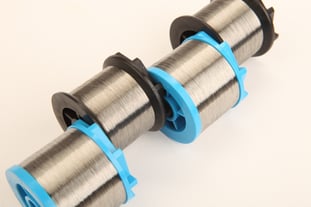We are often asked: How shiny is your medical wire? That’s a great question! And also a frustrating question. There is a lot of variation in bright and shiny, and currently no good method of measuring and reporting this characteristic consistently.
Here’s a little background: In most applications, bright and shiny is equated with clean and quality. And for good reason – the appearance of a fine diameter medical wire on its bobbin or spool can tell you a lot about what to expect in performance. If it’s dull, it could be oily and contaminate your device. If it has a matte appearance, the surface quality may be suspect and you could have issue with breaking in production. So, if you ask for and get bright and shiny wire out of the box, you should be OK, Right? Maybe.

With material characteristics in medical wire , you look to define quantitatively the performance parameters you desire: Tensile, break strength, stretch, etc. are defined and given a number. With wire brightness, which I’ll now start calling luster, the quantitative measurement is a bit elusive. There are methods of defining luster (such as Ra and RMS representations) but they were designed for metal forms other than wire and in sizes much larger than used in medical applications. Plus, these measurements are used to derive luster by measuring characteristics that contribute to luster (like surface finish or roughness). So, the lack of a good method for measuring a fine medical wire’s luster is one factor that makes defining bright and shiny difficult.
Another area of variation that stifles agreement on luster is the environmental differences when one examines the wire. The lighting on a shop floor and a testing lab can vary significantly, and cause the results of a qualitative review of fine medical wire to vary from person to person and company to company. Not that the differences don’t exist. Nor that they are inherently good or bad in this situation. It’s simply that these differences create variations that make it extremely difficult (if not impossible) to report a consistent, quantifiable luster measurement on which to base assumptions and develop parameters for evaluation.
And the result of these two contributors is that there is no easy way to define and report “Bright and Shiny”. In the absence of a quantifiable luster measurement, most manufacturers, including Loos & Company’s Medical Technologies Division, develop quality standards for comparison and work with customers to build a consistent, repeatable output that meets the needs of the device and the marketplace. So the next time you ask how bright and shiny our fine medical wire is you’ll understand why we answer that question the way we do. And you can also be assured that while the luster of wire can vary depending on how you look at it, the quality and performance that you get from our medical wire products never will!
If you have any questions about these or any of our medical wire, cable, and cable assembly products, don’t hesitate to contact us today.



